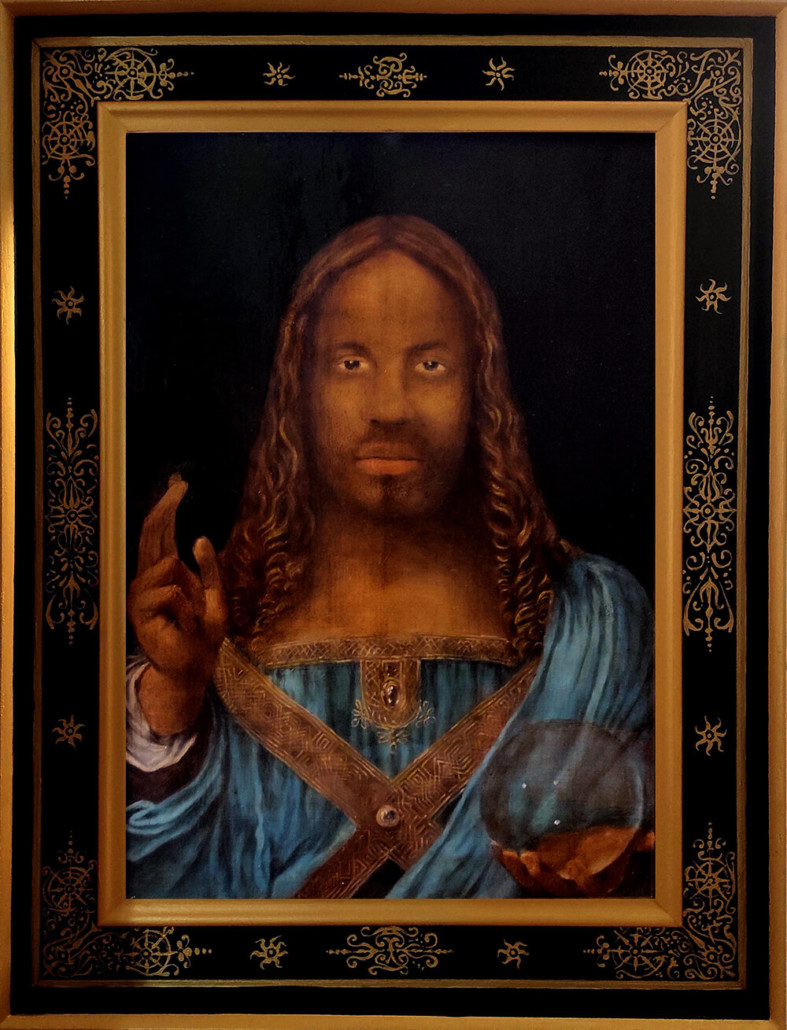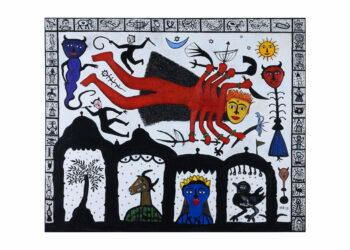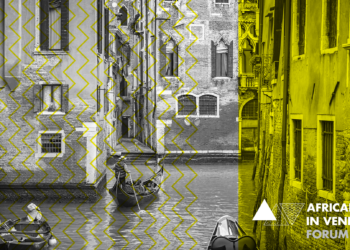The immense growth of African art is celebrated and certified with Cameroon’s first historic participation in the 59th International Art Exhibition – La Biennale di Venezia

Jorge R Pombo, Variazione del ‘Salvator Mundi’ di Leonardo da Vinci (1), 2022. Oil on wood, 85,7 x 64,3cm (frame included, part of the painting). Courtesy of the artist & the Cameroon Pavilion.
Commissioner Armand Abanda Maye is proud that Cameroon is represented for the first time at the International Art Exhibition – La Biennale di Venezia with a very rich and spectacular project, curated by Emmanuel Paul Loga Mahop and Sandro Orlandi Stagl.
‘The Time of the Chimeras’, the exhibition of the Cameroonian Pavilion for the Biennale Arte 2022, is being developed in two distinct locations: a “physical” one, in a more traditional version, set up in the cloister housing the Guggenheim Art School, and another “digital”, at Palazzo Ca’ Bernardo Molon. Four artists from Cameroon and four international artists “dialogue” with each other about achievable dreams and possible utopias: this is the core concept of the exhibition. The title “The Time of the Chimeras” is directly linked to “The milk of dreams”, the title of the 59th International Art Exhibition – La Biennale di Venezia. The interpretation of the main theme proposed by the Cameroonian Pavilion has its roots between present and past, between reality and myth.
The country, which is currently striving to get out of the internal divisions and tensions, is at the same time experiencing a period of increasingly decisive pressure to participate actively in international progress. And in this context, many expatriate Cameroonians (among whom obviously also many artists), have preserved their national and African identity, even though being assimilated in the countries where they settled. And their values go beyond postcolonial claims, tending to restore their own culture to relate that to all others.
Sandro Orlandi Stagl, one of the curators of the exhibition, explains the choice of the exhibition’s title as follows: More and more driven by a strong social responsibility, in this direction the artists obey their instincts, apply themselves to realise their own impossible dreams, their own illusions and to strive to pursue their own chimeras. Everyone’s imagination, which manifests itself through creativity, vision and perseverance to avoid any compromise, is the driving force with which they manage to transform unrealisable dreams into reality. The mixture of fantasy and reality brings us back to the meaning and value of the “myth”, with all its symbolic connotations. Here is the approach to the Chimera that from a fantastic monster of oriental mythology, later developed by the Greeks, according to which it was an animal that spewed flames and whose body was composed of three animals, a lion, a goat and a snake, defeated in the end by the hero Bellerophon, it became, over the centuries, a symbol of illusions, bizarre ambitions, risky fantasies, unattainable dreams. Chasing a Chimera represents the desire to change something in one’s life as well as reality itself. Fighting a Chimera indicates the abandonment of one’s lower instincts and careful control of one’s human nature towards a higher condition. The artist, like the hero Bellerophon, uses all his skills and his commitment in order to defeat the monsters that populate our reality. Fantasy is his winning weapon, it has neither masters nor servants, it is free, it moves without borders, it explores space and travels through time. The artist can move mountains, as well as the most deeply rooted beliefs, he can divert rivers, so also the most widespread beliefs, can contain the waters of the seas as well as the pressure of the media influence. Then, if the imagination is combined with amazement, the sense of the “myth” comes to fruition and becomes the “archetype” for every artistic judgment.
The second big news, namely the presence of NFTs at the Biennale Arte 2022, directly concerns Cameroon because, as already mentioned, their presence will take place right inside the Cameroonian Pavilion, with over twenty participating artists from all over the world.
Projects and artists
The story of the individual projects is concise because some of them will be site-specific installations, so their description is at the moment generic and explanatory of the ideas developed.
The curators’ choice to present 4 artists belonging to the Movimento Arte Etica fits perfectly with
a general attitude of Social Responsibility for art, which has been promoted in the main installations
and in many of the NFT projects of the “digital” location.
- Angéle Etoundi Essamba: develops the theme of the bonds that are created between women and their land, inspired by the story of the Greek mythology of Athena and Arachne, with striking colourful photographs of African women who create symbolic relationships of connection and peace through threads whose colours have strong symbolic meanings;
- Francis Nathan Abiamba (Afran): prepares an original site-specific installation linked to the theme of the influence of communication on individuals, exploring the “hallucinogenic” world of fake news with a suggestive population of coloured mushrooms in the cloister of the Guggenheim high school; he also exhibits some canvases;
- Salifou Lindou: exhibits some original paintings resulting from introspection on the human body and presents an installation of painted African kettles, which represent the hotbeds of war in the world, together with an installation with a row of fans that make a group of invented flags (of different ethnic groups of Cameroon) flying in the same direction, a symbol of world cultures, imagining winds of peace rather than winds of war;
- Justine Gaga: presents an installation that reflects on the problems that contemporary society is experiencing, with the wood of totem poles enriched by words with strong symbolic values, all supporting an empty gas cylinder (in Africa cooking gas is still the main source of energy for houses of most of the inhabitants);
- Jorge R. Pombo: reflects on the theme of bodies and their metamorphosis and presents 4 variations of Leonardo da Vinci’s “Salvator Mundi”, the most valuable in history, but not the most iconic, revised with a version of the African black Christ (“If horses had God and were able to paint, they would paint it in the shape of a horse ”, Friedrich Nietzsche) and its nuanced variations towards the abstract, which leads to the spiritual essence that remains;
- Matteo Mezzadri: presents an installation centred on the cloister well, which transforms water into a dream. A dream of survival for many places in Africa, a dream of beauty in certain crystalline paradises, a very topical theme by virtue of the water crises that can now affect anywhere on the planet; an entire city of bricks around a black wall that surrounds the cloister’s well, protecting and oppressing it at the same time;
- Shay Frisch: presents electrical/luminous installations linked to the vision of a future world immersed in a constant flow of electromagnetic waves and the physical/emotional consequences that people feel in their presence, given the increasingly widespread diffusion of mobile phone communication, especially in African countries; his installation will be hosted in the NFT headquarters, acting as a trade union between the physical and digital world, also for the granularity of its suggestive installations, all created with thousands of electrical sockets;
- Umberto Mariani: prepares an installation of 28 works inspired by his drapery which are hung on the 28 windows of the cloister building a metaphor that, citing the White Sheet protest in Sicily, addresses the theme of corruption in the world, so widespread in African countries for the benefit of Western powers that exploit the resources of the black continent, but widespread also in Western countries, as terrible cancer and as an obstacle to the free market, to the development of people’s talents and merits;
- Headquarters dedicated to NFT digital works: the pavilion reflects on the relationship between individuals and technology by analysing this new market with an overview of the works of a selection of well-known and international NFT artists, all presented through multimedia systems such as screens, projectors, PCs and installations. Each project is the result of a new vision of the NFT world, where the quality of the works and the concepts developed are treated with great attention so that each work and each project is as profound and interesting as projects in the “physical” world already are.
List of participating artists: Kevin Abosch, João Angelini, Marco Bertìn (Berxit), Cryptoart Driver, Lana Denina, Alberto Echegaray Guevara, Genesis People, Joachim Hildebrand, Meng Huang, Eduardo Kac, Gyula Kosice, Julio Le Parc, Marina Nuñez, Miguel Soler-Roig, Miguel Ángel Vidal, Burkhard von Harder, Gabe Weis, Clark Winter, Shavonne Wong, Wang Xing, Alessandro Zannier, ZZH. For the first time, with the help of their colleagues, the first NFT works created by African artists and the international ones exhibiting “physical” works will also be hosted in the digital venue.
Special thanks to GCA DAO, Origini, Danesi Spa, Opero Srl, Professional Link Srl and Pomilio Blumm for the technical and economic support that allowed the realisation of the entire project.



